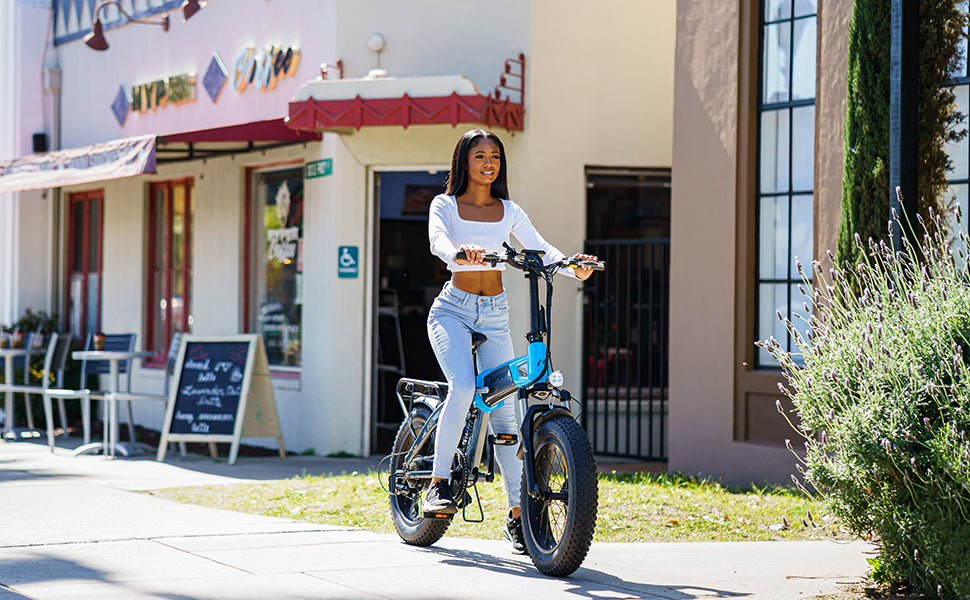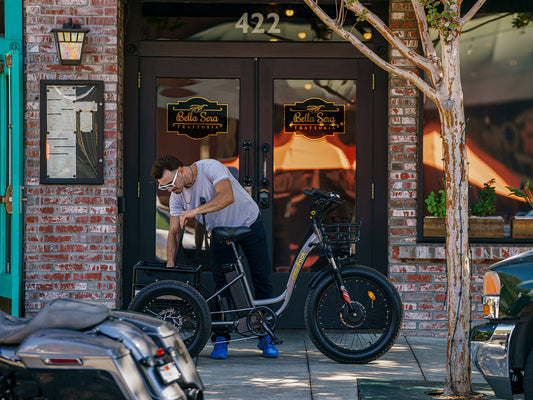Electric bikes are transforming the way people commute and enjoy outdoor recreation, but with this surge in popularity comes the need for better awareness of the rules that govern them.
Different states have varying e-bike regulations, and it’s crucial to understand the distinctions between electric bike classes.
This guide will explain the classifications, the key differences in pedal-assist and throttle-assist features, and where and how to ride your e-bike legally.
Understanding Electric Bike Classes
Electric bike classes in the US are established to help riders and manufacturers categorize different e-bikes based on their performance, speed capabilities, and how their motor systems are engaged.
This classification system helps regulate how and where e-bikes can be used to ensure safety and consistency across different jurisdictions.
The three primary electric bike classes are Class 1, Class 2, and Class 3. Each class has specific regulations regarding motor wattage, speed limitations, and how the motor provides assistance.
Class 1 E-Bikes
Class 1 e-bikes are often considered the most accessible and beginner-friendly option. These bikes use pedal-assist technology, meaning the motor activates only when the rider pedals. They do not have a throttle.
The motor assists up to a maximum PAS speed of 20 mph, after which the assistance cuts off, and the rider continues under their own power.
Class 1 e-bikes are often allowed on most bike paths, multi-use trails, and public roads where traditional bicycles are permitted because they closely mimic the experience of regular cycling.
Key Features of Class 1 E-Bikes:
- Pedal-assist only
- Maximum PAS speed: 20 mph
- No throttle, meaning you cannot propel the bike without pedaling
- Maximum motor wattage is typically up to 750 watts, but regulations may vary by state
Class 2 E-Bikes
Class 2 e-bikes have both pedal-assist and throttle-assist modes. Riders can engage the motor via a throttle (usually controlled by a twist or thumb lever) without needing to pedal.

However, like Class 1, the motor cuts off at a maximum throttle speed of 20 mph. Once this speed is reached, the rider must pedal or coast.
Because of their throttle functionality, Class 2 e-bikes offer greater flexibility for riders, especially in situations where pedaling may not be convenient, such as uphill climbs or when starting from a complete stop. These bikes are popular for short-distance commuting, urban riding, and as a mobility solution for those who might need extra assistance.
That said, the e-bikes in this class are often subject to additional restrictions.
Key Features of Class 2 E-Bikes:
- Pedal-assist and throttle-assist modes
- Maximum throttle speed: 20 mph
- Maximum PAS speed: 20 mph
- Maximum motor wattage is typically up to 750 watts
Class 3 E-Bikes
Class 3 e-bikes are the fastest category allowed on public roads. They only have pedal-assist functionality but can reach a maximum PAS speed of 28 mph.
Some Class 3 e-bikes also have a throttle, but it only functions up to 20 mph. Beyond that, only pedal-assist mode is allowed up to the higher speed limit.
Due to their higher speed capability, Class 3 e-bikes are preferred by commuters who need to cover longer distances quickly and efficiently. However, these e-bikes are also subject to more restrictive regulations. For example, they may be prohibited from certain bike paths and recreational trails. You can only ride these on roads and in-road bike lanes.
Key Features of Class 3 E-Bikes:
- Pedal assist up to 28 mph
- Throttle assist (if equipped) works up to 20 mph
- Maximum motor wattage is typically up to 750 watts
- May require speedometers
- May require riders to be at least 16 years old (varies by state) and wear a helmet
Pedal-Assist vs. Throttle-Assist
Understanding the difference between pedal-assist and throttle-assist modes is crucial when choosing an e-bike that fits your needs and complies with local regulations.
Pedal-Assist (PAS)
In pedal-assist systems, the motor provides assistance only when you’re actively pedaling. Sensors detect your pedaling speed and force and adjust the motor’s output accordingly.
This system offers a more natural cycling experience and extends the bike’s range since the motor isn’t running continuously at full power. It is standard on Class 1 and Class 3 e-bikes.
Advantages of Pedal-Assist:
- Mimics traditional cycling
- Conserves battery life
- Often allowed on more types of trails and paths
Throttle-Assist
Throttle-assist mode allows the rider to propel the bike without pedaling using a grip-twist or thumb-press throttle, similar to a motorcycle or scooter. This feature is beneficial for quick acceleration, climbing hills, or resting your legs.
It is primarily found on Class 2 e-bikes.
Advantages of Throttle-Assist:
- Provides motor power without pedaling
- Helpful for riders with limited mobility
- Convenient for stop-and-go traffic
E-Bike Regulations in the US
At the federal level, the Consumer Product Safety Commission defines an e-bike as a "low-speed electric bicycle" with fully operable pedals, a motor of less than 750 watts, and a maximum assisted speed of 20 mph on a flat surface when ridden by a user who weighs 170 lbs. and powered solely by the motor.
While the federal government defines e-bikes for manufacturing and product safety purposes, states have the authority to regulate their use on public roads, bike lanes, and trails.
Simply put, e-bike laws concerning e-bike classification, allowable speeds, age restrictions, helmet requirements, and where e-bikes can be ridden vary by state.
Which States Recognize the Three Electric Bike Classes?
The majority of states follow the three-tiered e-bike classification system outlined above.
States that do NOT recognize this system include Alaska, Hawaii, Kansas, Kentucky, Massachusetts, Montana, Nebraska, New Mexico, North Carolina, Oregon, Pennsylvania, Rhode Island, and South Carolina.
Which Class of E-Bikes Are Allowed on Which Trails?
According to the Bureau of Land Management, all three electric bike classes can be ridden on public lands managed by the BLM. So, any road or trail open for Off-Highway Vehicle (OHV) use is good to go.
If you want to travel on a trail only meant for traditional bikes and non-motorized travel, you’ll need written approval from a BLM officer or manager.
Depending on where you live, you may still face restrictions on which paths you can ride your e-bike. It’s always best to check your state and local regulations before hitting the trails.
Where You Can Ride Class 1 E-Bikes:
Class 1 e-bikes are typically the most trail-friendly option because their speed and power are considered less disruptive to other trail users.
Below is where you can ride a class 1 e-bike.
- Paved bike paths
- Multi-use trails
- Certain mountain biking trails (check local rules)
- Urban bike lanes
Where You Can Ride Class 2 E-Bikes:
Many recreational areas and bike paths prohibit Class 2 e-bikes because of their throttle functionality. However, they are usually allowed on paved surfaces and bike lanes within cities and urban environments.
Below is where you can ride a class 2 e-bike.
- Paved urban bike paths and lanes
- Some multi-use trails (check local laws)
- Certain state parks (restrictions may apply)
Where You Can Ride Class 3 E-Bikes:
These e-bikes are often treated similarly to mopeds or scooters, which means they are more heavily restricted when it comes to trail access. They are generally prohibited on recreational trails, mountain bike paths, and multi-use trails due to rider speed and safety concerns.
Below is where you can ride a class 3 e-bike.
- Bike lanes and on-road paths
- Streets with speed limits under 45 mph
- Certain commuter bike paths (check state and local laws)
Important: Always check the specific trail regulations and observe posted signs to ensure you ride legally and responsibly.
Is There a Minimum Age Requirement to Ride an E-Bike?
In most states, yes.
Alabama, Alaska, Michigan, North Dakota, Tennessee, Utah, and Virginia require e-bike riders to be at least 14 years old.
Other states, such as Georgia, Hawaii, Idaho, Indiana, Louisiana, Minnesota, New Jersey, New Mexico, Texas, and West Virginia, have a 15-year age requirement.
Furthermore, in Arkansas, California, Colorado, Connecticut, Delaware, Florida, Illinois, Maine, Massachusetts, Maryland, Missouri, New Hampshire, New York, North Carolina, Ohio, Oklahoma, Oregon, Pennsylvania, South Dakota, Vermont, Washington, and Wisconsin, you must be at least 16 years to ride an e-bike.
The only state with an 18-year minimum age requirement is South Carolina.
There’s no minimum age requirement for riding electric bikes in the remaining states.
Which States Require E-Bike Registration?
Registering your e-bike is mandatory in Alabama, Alaska, Hawaii, Louisiana, Massachusetts, New Mexico, North Dakota, West Virginia, and Wisconsin.
What about License Requirements?
Alabama, Alaska, Connecticut, Hawaii, Louisiana, Massachusetts, Missouri, New Jersey, New Mexico, North Dakota, West Virginia, and Wisconsin require you to have an e-bike license.
What Are the Helmet Requirements in Different States?
Helmet laws vary across the US, with some states mandating helmets for all riders and others imposing age-specific requirements.
Here’s a breakdown of helmet requirements in several states:
|
States |
Helmet Requirement |
|
Connecticut Hawaii |
All riders under the age of 15 must wear a helmet. |
|
Ohio |
Riders under 16 years of age must wear a helmet. |
|
Delaware |
Under 18 riders must wear a helmet. |
|
Georgia Idaho |
All riders and passengers, regardless of age, must wear a helmet. |
|
New York State |
All cyclists aged 14 and under are required to wear a helmet. |
Disclaimer: E-bike regulations are constantly changing. It’s your responsibility to stay up to date with your state and local laws and follow them to avoid legal action.
E-Bike Safety Tips
Safety should be a top priority when riding an e-bike. Here are some essential e-bike safety practices you need to follow at all costs:
1. Wear Protective Gear
Always wear a helmet, regardless of whether it’s legally required in your state. A helmet can significantly reduce the risk of head injuries in the event of a fall or collision.
Additionally, wearing protective clothing such as gloves, reflective vests, and sturdy footwear can enhance your visibility and safety on the road, especially during nighttime rides or in adverse weather conditions.
2. Be Visible and Predictable
You need to make yourself as visible as possible to stay safe while riding.
Use front and rear lights, and equip your bike with reflectors, especially when riding in low-light conditions like dawn, dusk, or nighttime. Clear hand signals should be used to indicate turns or stops to motorists and other cyclists.
3. Follow Traffic Laws
As an e-bike rider, you must obey the same traffic laws as motor vehicles. This includes stopping at red lights and stop signs, following posted traffic signs, and riding with the flow of traffic on the right side of the road.
You should also yield to pedestrians at crosswalks and shared paths, giving them the right of way to prevent accidents.
4. Keep Your E-Bike Well-Maintained
Proper maintenance is key to ensuring your e-bike performs reliably and safely. Always check your brakes before each ride to confirm they are functioning properly. Inspect your tires regularly for wear and ensure they are inflated to the correct pressure.
Also, follow the manufacturer’s guidelines for battery care, including proper charging and storage, to avoid battery malfunctions that could lead to safety risks.
5. Be Mindful of Speed
Riding at higher speeds increases the likelihood of accidents and more severe injuries. Always ride at a speed that suits the road conditions and your level of experience. Slowing down in busy areas, sharp turns, or unfamiliar terrain can help you maintain control and react quickly to potential hazards.
Final Words
The world of e-bikes is continually evolving, and staying informed will help you make the most of your e-biking adventures.
Take the time to research your local laws before hitting the road or trail, and perhaps even join an e-biking group or community.
Stay safe, and have fun!




